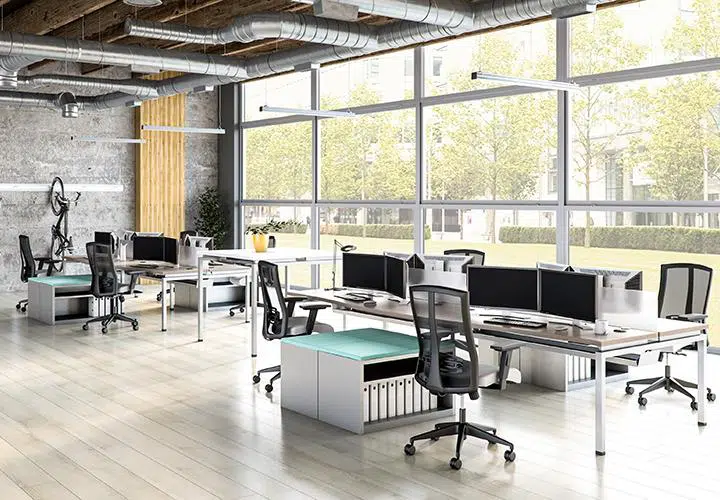
03 Jun Blending Different Age Groups Into Workspace Design
Blending Different Age Groups Into Workspace Design
According to FastCompany, “Creativity is vital in today’s workforce, given that no two generations are the same. Boomers and the “silent generation” feel they are being phased out by technology. Millennials feel they drew the short straw with the job market. Gen-Xers feel like the sandwich generation, often forgotten or ignored. Gen-Zers want to change the world but feel stymied by outdated practices.”
When looking across generations we found that every generation in the workforce has one thing in common: wanting to be heard.
What is the best way to hear what your employees want? Leaders should survey their employees to find out what types of spaces work for them. According to Harvard Business Review, even in the age of algorithms, surveying employees is still an effective way of understanding their needs and predicting future behaviors. RI Workplace’s Rate Your Office survey can help simplify the feedback gathering process.
Communication and Collaboration
Identify methods of communication that work for all generations and set a meeting schedule that fits well with all schedules.
Silents and Baby Boomers may appreciate verbal communication about changes in policy or procedures, while Generation Xers and Millennials may prefer the use of e-mail, instant messages, or corporate broadcasts.
A study by Generation.com of early-millennials, late-millennials, and gen-Zers found that in-person was their self-described weakest form of communication–by as much as 74%. The communication forms they like the best are video and text messaging.
Professional Development
- Employees of every generation are wondering what the future holds for them.
- AARP research found 33% of workers over the age of 45 felt they were vulnerable because of their age.
- Lack of career options is the top reason that early millennials and recessionists will leave an organization.
- Make sure to build a culture of authenticity and creative career development in order to retain top talent.
Respect the Goals for Different Groups
Baby Boomers are looking to be engaged.
- This generation values personal growth, team involvement, and personal gratification. Gallup’s decades of analytics point to one clear solution for optimizing baby boomers’ potential: empowering managers by transforming them into coaches who cultivate world-class engagement.
- To work effectively with Boomers, show them how they can be an organizational star, provide them with developmental opportunities, and involve them in operational matters.
Gen-X are looking for work/life balance.
- They value diversity, work/life balance, technology, and informality. A critical insight into understanding this generation is that they tend to view all work as just a job.
- To work effectively with Generation X, partner them with mentors that they respect, do not expect them to “give their life to the job” (instead promote work/life balance).
Early Millennials are looking for autonomy.
- Gen-Y or Early Millennials value civic duty, achievement, sociability, and multi-tasking. They are open-minded, the most accepting of diversity, and unafraid of change.
- Choosing the hours they work
- Having input over their work
- Owning their own company
Recessionist Millennials are looking for financial stability.
- Spending freely without hesitation
- Making enough money to pay off debts
- Able to save and invest
Gen Edgers are looking for societal impact.
- Making a difference at work
- Working for a company that gives back to the community
- Working for a company that takes a stand on important issues
- Concerned about not having their dream job and not enjoying their job. Focus on having them enjoy the job beyond the finances.
By understanding the strengths, limitations, and values of each generation, managers and leaders can minimize generational collisions.
So, what can you do to encourage successful mingling and beneficial working relationships between these very different groups of employees?
“There is no substitute for creating an open workplace that fosters open communication among employees and is carried out without prejudice of what one’s job title is,” explains Marshburn, “This creates transparency and allows everyone to feel like they have a stake in the direction of the company. Moreover, it forces both sides to see and come to grips with the other’s viewpoint.”
According to WorkDesign Magazine, “Through our experience, we’ve found companies that blend a healthy mix of both focused work and collaborative activity areas, allow their employees to be incredibly productive individually while, simultaneously, extremely innovative collectively.”
Key Take-Aways for Designing a Satisfactory Workspace for all Age Groups:
- A healthy mix of both focused work and collaborative activity areas
- Ask your employees before you design your space
- Communicate with each generation what works best for them
Contact RI Workplace today if you have any questions.
Source:
- http://www.generations.com/wp-content/uploads/2017/01/2017-BridgeWorks-3G-Report.pdf
- https://www.fastcompany.com/90302569/there-are-now-5-generations-in-the-workforce-can-they-work-together
- https://www.gallup.com/workplace/246443/best-baby-boomers.aspx
- https://www.amanet.org/articles/leading-the-four-generations-at-work/
- https://managementisajourney.com/understanding-and-managing-the-4-generations-in-the-workplace/
- https://officeninjas.com/mixing-millennials-and-baby-boomers-in-the-workplace-melting-pot/



















